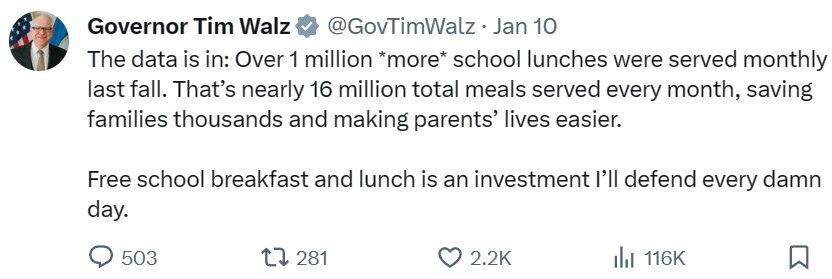Walz takes victory lap on over-budget free-food program
The brand-new Free School Meals for Kids Program just started, and it’s already 20 percent over budget.
The state’s governor and lt. governor were in Maplewood on Wednesday, serving “free” food to elementary school students and touting the over-budget program as a huge “win” for the state. KTTC reports,
According to the Governor’s Office, the state served up an additional 1.1 million lunches and 1.1 million breakfasts in the first month of operation. When compared to 2022 the markups represent a 11-percent and 31-percent increase, respectively.
Double-digit increases in school lunches? Color me skeptical. Of all the goods sold in the history of America, I would have imagined public school cafeteria food to be the most immune to the concept of price elasticity of demand.
I first wrote about these cost-overruns after finding them buried on page 58 of this budget document released in early December.
The brand-new program was estimated to be $81 million over its two-year budget of $400 million after just its first month of operation. The program was designed to backfill public schools for the revenue they used to receive from selling meals to kids during the school day. It did not actually expand any existing public school food offerings. Management and Budget accountants attribute the 20 percent cost overrun to a combination of more cafeteria food demand and higher than anticipated cost inflation.
The $81 million food overrun represents 40 percent of the entire estimated cost overrun for the entire K-12 Education budget category, the state’s largest single spending item.
The higher-than-anticipated uptake in free meals flies in the face of the state’s overall demographic trends. The most recent public school enrollment data dates from the last school year (2022-23). At the time that data was first released, it was noted that Minnesota continued the trend of three consecutive years of decline in public-school enrollment. The Minneapolis Star Tribune reported in February 2023,
Minnesota’s public school enrollment slipped for the third consecutive year last fall, according to state data released Thursday, but the losses are not as steep as at the height of the pandemic.
Even before the pandemic, some of the state’s largest school districts were suffering from chronic absenteeism, along the lines of 20 percent. Since the pandemic, that figure has soared above 50 percent. (Here, “chronic” is defined by missing more than two week per year.)
According to the state’s Department of Education (MDE), public school enrollment stood at 870,693 last year. According to MDE, the number of schoolchildren already eligible for the previous free and reduced-price lunch program stood at 378,245. So, we are only speaking of the increased appetite of the remaining 492,000.
This half-million or so share of the student population is said to be consuming millions of additional meals per month.
The governor wrote on Twitter (X) yesterday,

The 16 million meal number dates from September 2023. Many school districts didn’t even begin until after Labor Day. 16 million divided by 19 school days equals 842,105. So that’s nearly every enrolled child eating either a school lunch, a school breakfast, or both.
One national estimate has 40 percent of kids brown-bagging it.
In the face of declining enrollments and soaring absenteeism, we have a surging demand for public school cafeteria food.
The Feeding Our Future scandal has produced 17 criminal convictions to date. School lunch advocates point out that the Feeding scandal is mostly associated with nonprofit and private companies. The Free School Meals program involves state government distributing tax dollars to local units of government (public school districts). Government employees are believed to be immune to the temptations of greed.
Despite the fact that the state legislature “fully funded” the public schools last year, schools are still pleading poverty and projecting deficits.
It’s hard to believe that zero temptation exists to fudge some number on children served to squeeze a few more dollars out of the state’s newest entitlement program.
After all, it’s for the children.